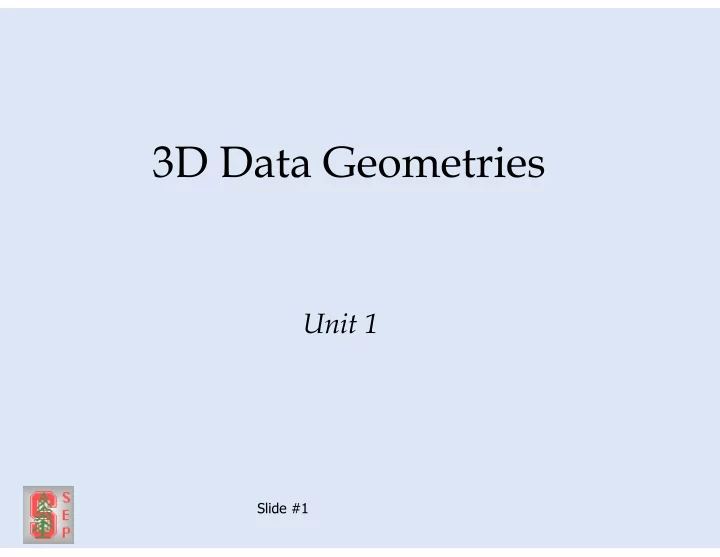

3D Data Geometries Unit 1 Slide #1
Field data acquisition Slide #2 biondo@stanford.edu
Field data geometry Sources ( s) Receivers ( g) Slide #3 biondo@stanford.edu
Two marine shot gathers geometry Slide #4 Figure 1.3 biondo@stanford.edu
From field coordinates to midpoint-offset coordinates Slide #5 Figure 1.1 biondo@stanford.edu
Midpoint-offset transformation m = g + s , 2 h = g − s , Trace azimuth 2 ( ) = h cos θ h ,sin θ h ( ) h = h x , h y Slide #6 Eq. 1.1 biondo@stanford.edu
3D data acquisition geometries Marine-data geometries Towed streamers geometries OBC and OBS geometries Land-data geometries Cross-swath geometries Button-patch geometries Slide #7 biondo@stanford.edu
3D data acquisition geometries Marine-data geometries Towed streamers geometries OBC and OBS geometries Land-data geometries Cross-swath geometries Button-patch geometries Slide #8 biondo@stanford.edu
Marine streamer acquisition Slide #9 Figure 1.2 biondo@stanford.edu
Field coordinates Slide #10 Figure 1.3 biondo@stanford.edu
Offsets distribution of marine data Slide #11 Figure 1.4 biondo@stanford.edu
Single-Azimuth Acquisition Slide #12 biondo@stanford.edu
Multi-Azimuth Acquisition Slide #13 biondo@stanford.edu
Wide-Azimuth Towed Streamers (WATS) Courtesy of Carl Regone (BP) Slide #14 Figure 1.5 biondo@stanford.edu
Rich Azimuth acquisition (RAZ) Courtesy of Mike Howard (BHP Billiton) and Nick Moldoveanu (WesternGeco) Slide #15 Figure 1.6 biondo@stanford.edu
RAZ in the Gulf of Mexico Inner lines—Racetrack Outer lines—120 degree turns The sail lines and obstructions are drawn to illustrate the general concept and differ from the actual survey. The square represents source coverage from E-W lines with the hexagon covered from three directions. Courtesy of Mike Howard (BHP Billiton) and Nick Moldoveanu (WesternGeco) Slide #16 biondo@stanford.edu
WAZ development type configurations BP WATS (2005-2006) Shell Friesian (2006) CGGV acquisition WesternGeco acquisition
BHP Rich-azimuth 2006 Shenzi survey WesternGeco acquisition
Wide-azimuth for exploration with 2 receiver vessels and 2 source vessels 10 streamers 8000 m 120 m 8475 cui arrays 4200 m X-offs. WesternGeco acquisition
Full Azimuth Single vessel Coil shooting WesternGeco acquisition
Full Azimuth Long Offset Multivessel Coil Shooting Configuration: two recording vessels and two source vessels • S1 • S4 • S2 • S3 WesternGeco acquisition
Offset-azimuth distribution for multivessel coil shooting 14 km 12 km 10 km 8 km
3D data acquisition geometries Marine-data geometries Towed streamers geometries OBC and OBS geometries Land-data geometries Cross-swath geometries Button-patch geometries Slide #23 biondo@stanford.edu
Two OBC shot gathers geometry Slide #24 Figure 1.7 biondo@stanford.edu
One OBC receiver gather geometry Slide #25 Figure 1.8 biondo@stanford.edu
Offsets distribution of OBC data Slide #26 Figure 1.9 biondo@stanford.edu
OBS in the Gulf of Mexico Water depth ~ 4500 ft Water depth ~ 7000 ft Courtesy of Jerry Beaudoin and Alan Ross (BP) and BP partners in Atlantis Slide #27 Figure 1.10 biondo@stanford.edu
Wide-azimuth vs. narrow-azimuth Courtesy of Carl Regone (BP) Slide #28 Figure 9.13 biondo@stanford.edu
Narrow-azimuth acquisition Courtesy of Carl Regone (BP) Slide #29 Figure 9.14 biondo@stanford.edu
Wide-azimuth acquisition - 1 pass Courtesy of Carl Regone (BP) Slide #30 Figure 9.17 biondo@stanford.edu
Wide-azimuth acquisition - 2 passes Courtesy of Carl Regone (BP) Slide #31 Figure 9.16 biondo@stanford.edu
Wide-azimuth acquisition - 4 passes Courtesy of Carl Regone (BP) Slide #32 Figure 9.15 biondo@stanford.edu
Wide-azimuth acquisition -OBS Courtesy of Carl Regone (BP) Slide #33 Figure 9.18 biondo@stanford.edu
Wide-azimuth vs. narrow-azimuth Gulf of Mexico data Courtesy of BP, www.bp.com, Technology Webcast, December 2005 Slide #34 Figure 9.19 biondo@stanford.edu
Imaging gains from RAZ data Rich Azimuth image Narrow-Azimuth image Courtesy of Mike Howard (BHP Billiton) and Nick Moldoveanu (WesternGeco) Slide #35 Figure 9.20 biondo@stanford.edu
3D data acquisition geometries Marine-data geometries Towed streamers geometries OBC and OBS geometries Land-data geometries Cross-swath geometries Button-patch geometries Slide #36 biondo@stanford.edu
Two land shot gathers geometry Slide #37 Figure 1.11 biondo@stanford.edu
Offsets distribution of land data Slide #38 Figure 1.12 biondo@stanford.edu
3D data acquisition geometries Marine-data geometries Towed streamers geometries OBC and OBS geometries Land-data geometries Cross-swath geometries Button-patch geometries Slide #39 biondo@stanford.edu
Button-patch acquisition geometry Slide #40 Figure 1.13 biondo@stanford.edu
One button-patch shot gather Slide #41 Figure 1.14 biondo@stanford.edu
“Isotropic” offsets distribution Slide #42 Figure 1.15 biondo@stanford.edu
Range of offsets distributions Slide #43 Figure 1.16 biondo@stanford.edu
Binning in the midpoint plane Slide #44 Figure 1.17 biondo@stanford.edu
Quiz #2 Slide #45
Slide #46 biondo@stanford.edu
Recommend
More recommend